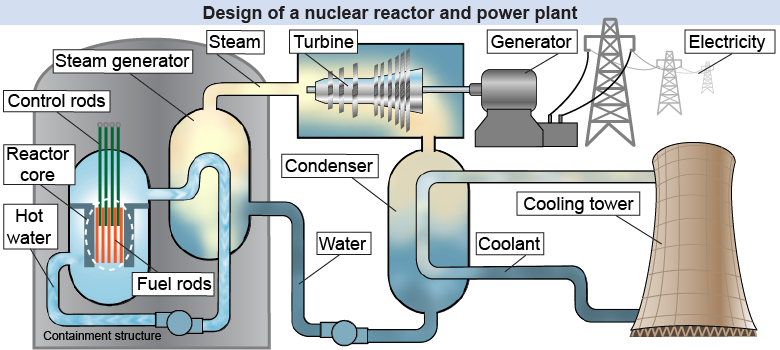|
The term nuclear energy is generally used to refer to nuclear fission reactions that are maintained through a chain reaction. Each fission reaction produces a significant amount of energy that can be transformed into other forms of energy—such as by heating water into steam. The steam can turn a steam turbine, creating mechanical energy, which then powers an electric generator to turn the energy into electricity. Nuclear power is typically used to generate electricity. In the USA, which is the world’s largest producer of nuclear power, about 20% of the electricity is generated by nuclear reactors. 
|

|
At the heart of a nuclear power plant is the reactor core containing the nuclear fuel rods immersed in a circulating water system. It includes all the radioactive systems, and it is housed in a thick containment vessel. Water heated by the nuclear reactions exchanges energy with a secondary water system, which drives the steam turbine to generate electricity. Water from the secondary system exchanges heat with a tertiary system, which directs water into the large cooling tower. A key design principle of the nuclear power plant is to keep all the radioactive material (fuel rods and water) in the primary containment system, so that the other parts of the system do not become radioactive. 
|
One fundamental challenge in the design of a nuclear reactor is that the fission reaction requires a slow neutron to hit the uranium nucleus, yet highly energetic neutrons are produced by a fission reaction. In most reactors the fuel is immersed in water, which acts as a moderator, slowing down the speed of the neutrons enough that they can initiate new fission reactions to carry on the chain reaction. The second challenge is preventing the nuclear reaction from becoming uncontrolled. Control rods are used in a nuclear reactor to limit the rate of fission reactions to a safe level. 
|
One technical problem with nuclear fission reactions is that the spent fuel, although not capable of producing enough reactions to drive the reactor, remains radioactive for many years. Nuclear reactors create nuclear waste that must be stored for a long time in shielded containers at a safe site. In the USA, no long-term storage site has been agreed upon. Consequently, nuclear engineers must design nuclear power plants to store most nuclear waste on-site. 
|
In the diagram of the nuclear power plant, how many different loops are there for liquid to flow through? - 1
- 2
- 3
- 4
 |
The correct answer is c, 3. There is a first loop that gets heated by the nuclear reaction and acts as a moderator. There is a second loop that takes the heat from the first loop, boils water into steam, and spins the turbine. There is a third loop that cools off the second loop and runs through the cooling towers. The loops are separate because this keeps the radioactive water separate from the loop that goes outside into the turbine. This prevents the radioactivity from escaping. 
|
| |
|

